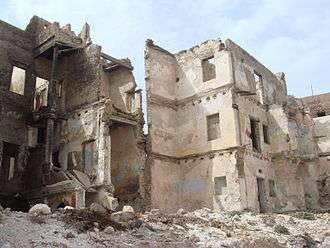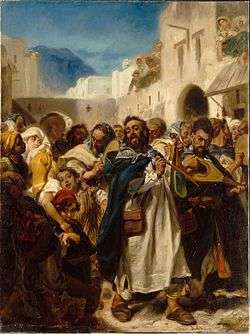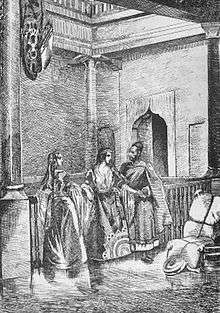Moroccan Jews
| Total population | |
|---|---|
| 1,180,000 | |
| Regions with significant populations | |
| 1,000,000[1] | |
| ~150,000[2] | |
| ~27,000[3][4] | |
| ~11,600[5] | |
| ~6,000[6] | |
| 6,000[7] | |
| 2,000-10,000[8] | |
| 700[9] | |
| 567[10] | |
| 500[11] | |
| Languages | |
| Arabic, Berber, Hebrew, French, Haketia, Spanish. | |
| Religion | |
| Judaism | |
| Related ethnic groups | |
| Other Mizrahi Jews, Sephardi Jews, Ashkenazi Jews | |
Moroccan Jews (Arabic: اليهود المغاربة al-Yehud al-Magharibah, Hebrew: יהודים מרוקאים Yehudim Maroka'im) are the Jews who live or lived in the area of North Africa known as Morocco. The first Jews migrated to this area after the destruction of the First Temple in Jerusalem and settled among the Berbers. They were later met by a second wave of migration from the Iberian peninsula in the period immediately preceding and following the 1492 Alhambra Decree, when the Jews were expelled from kingdoms of Spain, and soon afterwards, from Portugal as well. This second immigration wave deeply modified Moroccan jewry, who largely embraced the Andalusian Sephardic liturgy, making the Moroccan Jews switch to a mostly Sephardic identity.
At its peak in the 1940s, Morocco's Jewish population exceeded 250,000, but following Operation Yachin this number has been reduced to approximately 5,000. The vast majority of Moroccan Jews now live in Israel, where they constitute the second-largest Jewish community (approximatively 1 million). Other communities are found in France, Canada, Spain, the United States and South America, mainly in Venezuela, Brazil and Argentina.
History
Moroccan Jews constitute an ancient community, immigrating to the region as early as 70 CE. Until the 1950s the majority of Morocco's Jews were still living in Morocco. In accordance with the norms of Islamic legal system, Jewish Moroccans had separate legal courts pertaining to "personal law" under which communities (Muslim sharia, Christian Canon law and Jewish halakha law abiding) were allowed to rule themselves under their own system. After Israel's independence in 1948, and due to domestic strife in the 1950s, the next several decades saw waves of Jewish emigration to Israel, France and Canada. Moroccan Jews emigrated for a variety of reasons. Some have emigrated to Israel for religious reasons, some faced persecution, and others left for better economic prospects than they faced in post-colonial Morocco. With every Arab-Israeli war, tensions between Arabs and Jews would rise, sparking more Jewish emigration. By the time of the Yom Kippur War in 1973, the majority of Morocco's Jewish population had emigrated.[12]
A small community of around 2,000-2,500 Jews live in Morocco today. However, in a rapidly increasing trend, young men from the community are emigrating to Israel and France.[13]
As a protectorate of France, parts of Morocco were heavily influenced by French culture, while the same is true of the portions of the country that belonged to Spain. Traditionally, the Jews were classified as being French-Moroccan or Spanish-Moroccan depending on where in Morocco they lived, and remnants of these classifications can be felt today. These differences are reflected in language, foods, last names and even liturgy.
Early photographs of Moroccan Jewish families, taken in the early 20th century by German explorer and photographer, Hermann Burchardt, are now held at the Ethnological Museum of Berlin.[14]
Communities today


- Morocco: In 2012 it was estimated that 2,000-2,500 Jews still lived in Morocco, mainly in Casablanca.[15] Other towns are said to have smaller, aging populations.
- Israel: The 1950s saw large waves of Jewish emigration from Morocco to Israel. Many Moroccan Jews were transferred to peripheral development towns while others settled in larger, established cities. Today, Jews of Moroccan descent can be found all across Israel.
- France: Large communities in France include Paris, Marseille, Strasbourg, Lyon and Nice.
- Argentina: Mainly in Buenos Aires and Rosario.
- Brazil: Amazonian Jews mainly in Belem (about 450 families), Manaus (about 250 families) and Rio de Janeiro (about 100 families),[16] with small communities scattered throughout the Amazon region. In 2009 made 200 years of the first wave of immigration to Amazon region.[17]
- Canada: In the 1950s Canada began extending visas to Jews from Morocco. Large communities developed in Montreal and Toronto. Moroccans were attracted to Canada because of its high quality of life and to Montreal in particular because of the French language. Toronto is known for its significant Moroccan population originating from cities such as Tangiers and Tetouan. In recent past, however, an emergence of French-Moroccan musical liturgy and customs has been noticed even in this dominant Moroccan city. For example, the traditional Moroccan Bakashot, classical music sung by Sephardic Jews in the winter months across countries in the Middle East on Friday night, has come to life in recent productions by Magen David Congregation and Abir Ya'akob Congregation.
- Venezuela: Concentrated mainly in Caracas.
- Gibraltar: The Jewish community in Gibraltar originates from Tangiers and Tetouan.
Culture
Moroccan Jewry has developed as a hybrid of the many cultures that have shaped Morocco itself, namely Jewish, Arab, Berber, French and Spanish.
Music

Even before the arrival of Sephardi Jews to Morocco, Moroccan Jews performed and developed the traditions of the Andalusian classical music and introduced it into their Liturgical music. In his book "Jews of Andalusia and the Maghreb" on the musical traditions in Jewish societies of North Africa, Haim Zafrani writes: "In Spain and Morocco, Jews were ardent maintainers of Andalusian music and the zealous guardians of its old traditions ...."[18]
Henna
Traditional Henna parties usually take place within the week before a special occasion, such as a wedding, Bar and Bat Mitzvah, or baby showers. During pre-wedding Henna parties, the Matriarch of the family (often the grandmother) smudges henna in the palm of the bride and groom to symbolically bestow the new couple with good health, fertility, wisdom, and security. The henna is believed in Moroccan tradition to protect the couple from demons. The grandmother covers the henna, a dough-like paste produced by mixing crushed henna plant leaves with water, in order to lock in body heat and generate a richer color. Normally, the henna will dye skin orange for up to 2 weeks. In Moroccan folklore, the bride is exempt of her household duties until the henna completely fades. After the bride and groom are blessed with the henna, the guests also spread henna on their palms to bring good luck.
Clothing
Although most Moroccan Jews tend to dress in styles of their adopted countries, traditional Moroccan clothing is sometimes worn during celebrations (Mimouna, weddings, Bar Miṣvas, etc.) or even during more intimate gatherings, such as Shabbat dinner. Men usually wear a white jellaba (jellabiya) cloak while women wear more ornate kaftans.
Mimouna
Mimouna is celebrated by many Moroccan Jews on the night following the last day of Passover. It has spread to be an almost national holiday in Israel where it is particularly prelavent in the city of Haifa.
Religious observance
Many Rabanim have passed through and sojourned in Morocco leaving behind great influence. In 2008, a project to preserve Moroccan Torah and the words of its Ḥakhamim was initiated. DarkeAbotenou.com was created by a few members of the Toronto Sephardic Community; devoting their time and effort to increasing global awareness of the customs and laws that Jews of Morocco live with every day. Daily emails are sent in both English and French containing the customs, laws, and traditional liturgy of both the French and Spanish parts of Morocco. This daily publication is currently broadcast in both English and French.[19]
Liturgy
The observer of a typical Moroccan Jewish prayer service will note the presence of Oriental motifs in the melodies. However, unlike the tunes of Eastern rites (Syrian, Iraqi, etc.), which were influenced by Middle Eastern sounds, Moroccan Jewish religious tunes have a uniquely Andalusian feel. Furthermore, just as Eastern liturgical melodies are organized into Maqams, Moroccan liturgy can be classified by Noubas. The Moroccan prayer rite itself is also unique among Sephardic customs. The Moroccan nusach has many unique components but has also incorporated numerous Ashkenazic customs due to the country's proximity and exposure to Europe. Some customs of the Moroccan nusach include:
- Two blessing for Hallel: One blessing (ligmor et ha'Hallel) is said when the full Hallel is recited, while the other blessing (likro et ha'Hallel) is said when the abridged Hallel is recited. Other Sephardim omit the latter.
- Yiru Enenu: The blessing commencing with the words Yiru Enenu (translation: Our eyes shall see) is recited after Hashkivenu in the Arvit service after the Sabbath. Many Ashkenazim say this passage on every weekday night after Hashkivenu. This custom is discussed in Tosafot of Tractate Berakhot 4a.
- Le'David: Before the Arvit service after the Sabbath, three psalms are recited in a unique tune said to be the same tune that King David's soldiers recited them in. The psalms are Chapters 144, 67 and 44 (in that order). Some congregations begin this service with Chapter 16 in a tune that leads up to the other three psalms.
- Pesukei Dezimra: The opening verse of Psalm 30 ("Mizmor Shir Ḥanukat Habayit LeDavid") is added to the remainder of the Psalm during Shaḥarit of Hanuka. Other Sepharadim begin with "Aromimkha" even on Ḥanuka.
- Shir HaShirim: This is usually read between Mincha and Kabbalat Shabbat on the Sabbath eve. Other Sephardic groups tend to read it before Minḥa. Moroccan Jews chant Shir HaShirim with a unique cantillation. A common practice is for a different congregant to sing each chapter.
- Before the repetition of the Amidah in Shaḥarit and Musaf of Rosh Hashana and Yom Kippur, the hymn "Hashem sham'ati shim'akha yareti" (Translation: Hashem, I have heard your speech and was awed) is sung. The origin of this verse is Habakkuk 3:2.
- The Moroccan tune for Torah Reading is unique to the Moroccan tradition, unlike all other Sephardic Jews who merely utilize different variations of the Yerushalmi tune.
Religious customs
- Psalm 29 and Lekha Dodi are recited sitting down in the Kabbalat Shabbat service.
- Packets of salt are distributed to congregants on the second night of Passover, marking the first counting of the 'Omer. The significance of salt includes the commemoration of the sacrifices in the Temple and other Kabbalistic reasons.[20]
- Pirke Avot is read during the Musaf service of Shabbat between Passover and Shavuot. As well, the custom is for pre-Bar Miṣva boys to read each chapter, and this is usually performed with a special tune.
- After reciting the hamotzie blessing over bread, there is a custom to dip the bread into salt while reciting "Adonai melekh, Adonai malakh, Adonai yimlokh le'olam va'ed" (Translation: God reigns; God has reigned; God will reign for ever and ever). This "verse" is actually a compilation of 3 verses taken from Psalms and Exodus. The validity of this custom has been disputed among Moroccan Poskim since it may constitute an interruption of a blessing.
- Before the Magid section of the Passover Seder, the Seder plate is raised and passed over the heads of those present while reciting "Bibhilu yaṣanu mi–miṣrayim, halaḥma 'anya bené ḥorin" (Translation: In haste we went out of Egypt [with our] bread of affliction, [now we are] free people). It can be heard here.[21]
Notable Moroccan Jews
- Reuven Abergel, founder of Israeli Black Panthers
- Linor Abargil, Israeli model
- Zohra Al Fassiya, classical singer from the 50's
- Michel Abitbol, scholar
- Yaakov Abuhatzeira, 19th-century rabbi
- Yisrael Abuhatzeira (Baba Sali), 20th-century rabbi
- Amram Aburbeh, chief rabbi of Petah Tikva
- Shlomo Amar, Sephardi Chief Rabbi of Israel
- Richard Attias, businessman
- Pierre Assouline, journalist
- André Azoulay, senior adviser to Mohammed VI of Morocco
- Yigal Azrouël, fashion designer
- Moshe Bar-Asher, linguist, president of the Academy of the Hebrew Language
- Baruj Benacerraf, immunologist, Nobel Prize laureate
- Elena Benarroch, fashion designer
- Isaac Benayon Sabbá, businessman
- Samuel Benchimol, businessman, professor, scientist and economist
- Amram ben Diwan, 18th-century rabbi
- Daniel Benlulu, politician
- Aldo Bensadoun, founder of ALDO Group footwear
- Daniel Ben-Simon, journalist, writer, politician
- David Bensoussan, engineering professor, Montreal Jewish communal leader and historian of the Jews of Morocco
- Simone Bitton, filmmaker
- Emmanuelle Chriqui, actress
- Ralph de Toledano, politician
- Aryeh Deri, Israeli politician
- Patrick Drahi, billionaire and founder of Altice
- Gadi Eisenkot, Chief of Staff of the Israel Defense Forces
- Alber Elbaz, fashion designer
- André Elbaz, painter and filmmaker
- Ronit Elkabetz, Israeli film maker
- Samy Elmaghribi, singer
- Edmond Amran El Maleh, writer
- Gad Elmaleh, comedian
- Arthur Essebag, television presenter
- Gregg L. Friedman, physician
- Samuel Hadida, film producer
- Serge Haroche, physicist, Nobel Prize laureate
- Maguy Kakon, author and politician
- Marc Lasry, billionaire hedge fund manager
- Moses Elias Levy, 19th-century international businessman and reformer
- Shlomit Malka, Israeli model for Intimissimi
- Paul Marciano, fashion designer
- Ya'akov Margi, politician
- Jacques Morali, producer, creator of Village People and the Ritchie Family
- Ze'ev Revach, Israeli actor
- Abraham Serfaty, politician
- Bechor-Shalom Sheetrit, politician
- Avi Toledano, Israeli singer
- Haim Zafrani, scholar and writer
- Shimon Marciano, entrepreneur
See also
- Amazonian Jews
- Moroccan Jews in Israel
- Migration of Moroccan Jews to Israel
- Operation Yachin
- The Jewish Community of Fez
References
- ↑ "Statistical Abstract of Israel 2009 - No. 60 Subject 2 - Table NO.24". Israeli government. Retrieved 12 December 2011.
- ↑ "Les Juifs marocains en France". Les Juifs marocains Dans Le Monde. Mimouna. Retrieved 12 December 2011.
- ↑ "Toronto". Les Juifs marocains Dans Le Monde. Mimouna. Retrieved 12 December 2011.
- ↑ "Montréal". Les Juifs marocains Dans Le Monde. Mimouna. Retrieved 12 December 2011.
- ↑ "Les Juifs marocains en Espagne". Les Juifs marocains Dans Le Monde. Mimouna. Retrieved 12 December 2011.
- ↑ "Les Juifs marocains au Vénézuela". Les Juifs marocains Dans Le Monde.
- ↑ "Les Juifs marocains au Brésil". Les Juifs marocains Dans Le Monde. Mimouna. Retrieved 12 December 2011.
- ↑ Sergio DellaPergola, World Jewish population, 2012, p. 62.
- ↑ "Les Juifs marocains à Gibraltar". Mimouna. Retrieved 12 December 2011.
- ↑
- ↑ "Les Juifs marocains en Argentine". Les Juifs marocains Dans Le Monde. Mimouna. Retrieved 12 December 2011.
- ↑ http://www.ynetnews.com/articles/0,7340,L-4350488,00.html
- ↑ http://www.ynetnews.com/articles/0,7340,L-4354823,00.html
- ↑ Jewish couple in Morocco on the roof of their house; Jewish family during the Feast of Tabernacles on the roof of their house; Moroccan Jews in 1905, by Hermann Burchardt; Jewish family, 1905; The Saba Synagogue, 1905; Jewish family in their home; The Ibn (Aben) Danan Synagogue, in the Mellah of Fès (click to enlarge); Jewish family in Morocco, early 20th century (click on photo to enlarge); Family portrait, Morocco.
- ↑ Sergio DellaPergola, World Jewish population, 2012, p. 62.
- ↑ http://aj200.blogspot.com.br/2010/02/linha-do-tempo-da-presenca-judaica-na.html?_sm_au_=iVVn4LMFSs4NJ7tr
- ↑ http://www.amazoniajudaica.org/167563/Quem-somos
- ↑ Haïm Zafrani (2002). Juifs d'Andalousie et du Maghreb. Références Maisonneuve et Larose. Maisonneuve & Larose. p. 228. ISBN 978-2-7068-1629-1.
- ↑ Darké Abotenou » About. Darkeabotenou.com (2008-11-21). Retrieved on 2011-07-04.
- ↑ "Salt of Omer" in the Kehila Centre Website. (PDF) . Retrieved on 2011-07-04.
- ↑ Pesah פסח – Bibhilou בבהילו – Jo 'Amar ג'ו עמר z"l on YouTube. Retrieved on 2011-07-04.
External links
- Official website of the Jewish community council of Morocco (French)
- David Bensoussan, Il était une fois le Maroc : témoignages du passé judéo-marocain, éd. du Lys, www.editionsdulys.com, Montréal, 2010 (ISBN 2-922505-14-6); Second edition : www.iuniverse.com, Bloomington, IN, 2012, ISBN 978-1-4759-2608-8, 620p. ISBN 978-1-4759-2609-5 (ebook);
- Daily Moroccan Halakha / La Halakha Marocaine Quotidienne
- Foundation for the Advancement of Sephardic Studies
- Diana Muir Appelbaum "The Last Berber Jews", Jewish Ideas Daily, August 10, 2011,
- Gressel, Madeline, Zoe Lake, Siyi Chen, Kelsey Doyle and Khadija Boukharfane. "In Morocco, Muslims and Jews study side-by-side but for how long?" (Archive). PBS Newshour. July 29, 2015.
